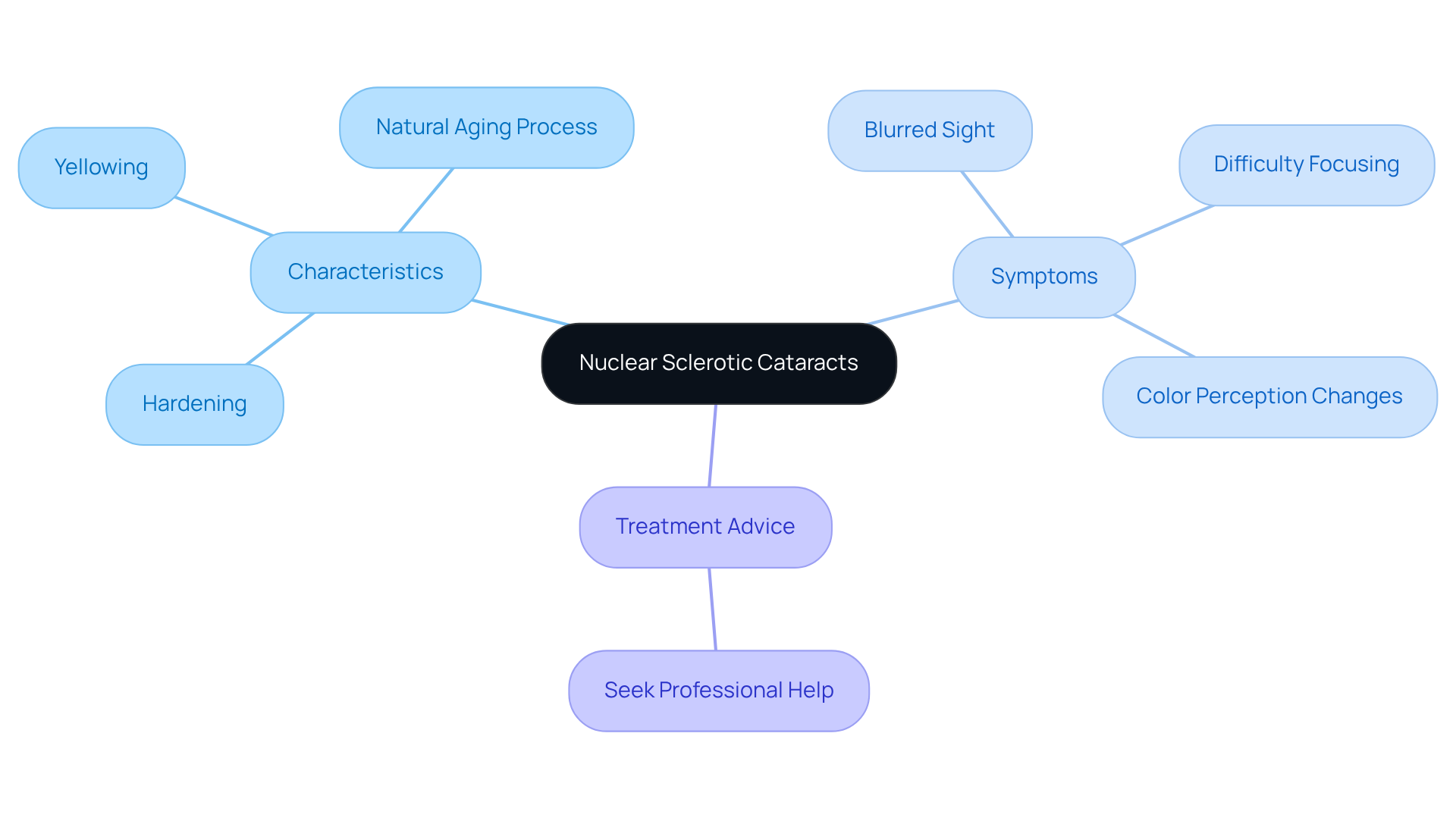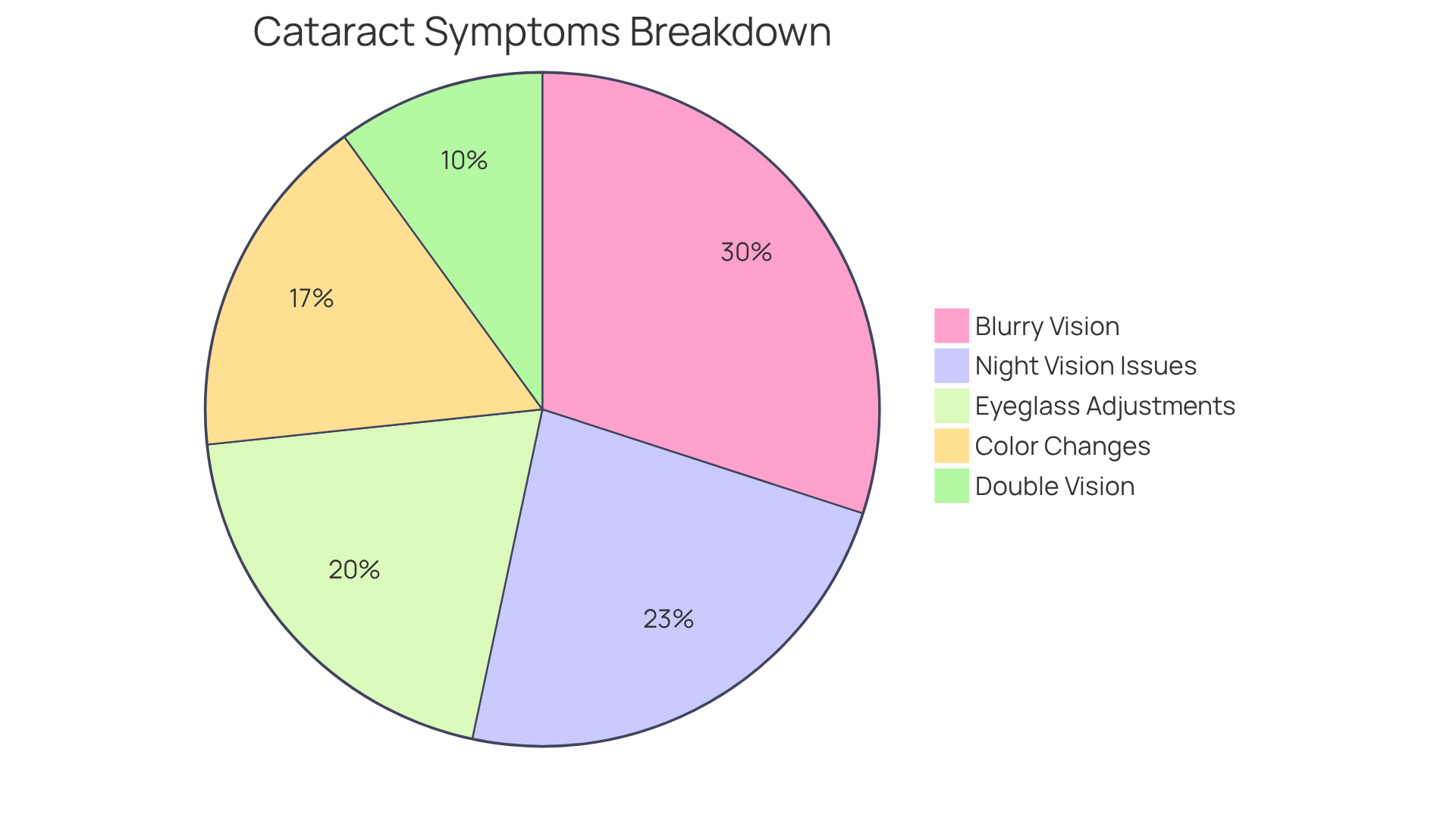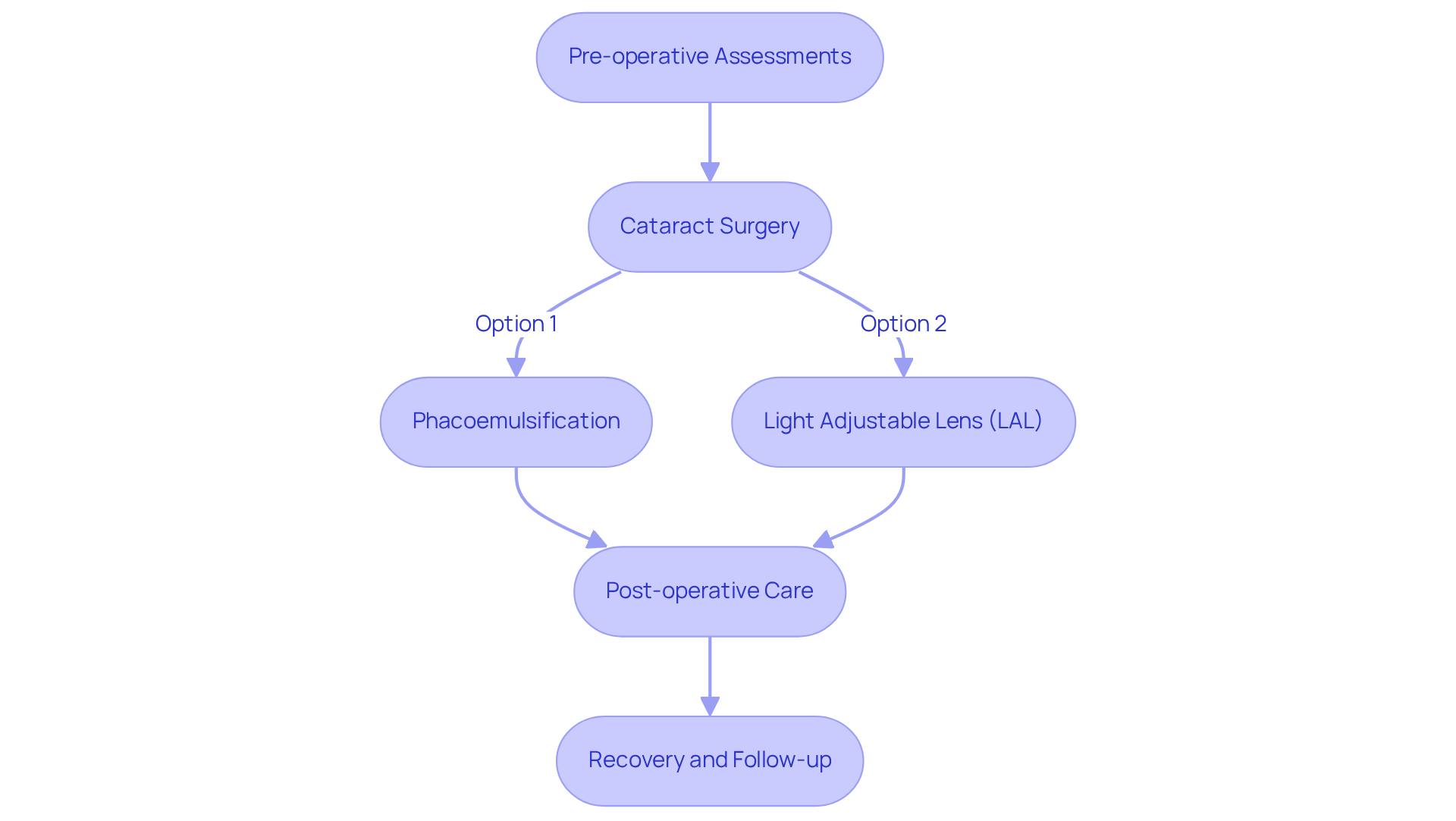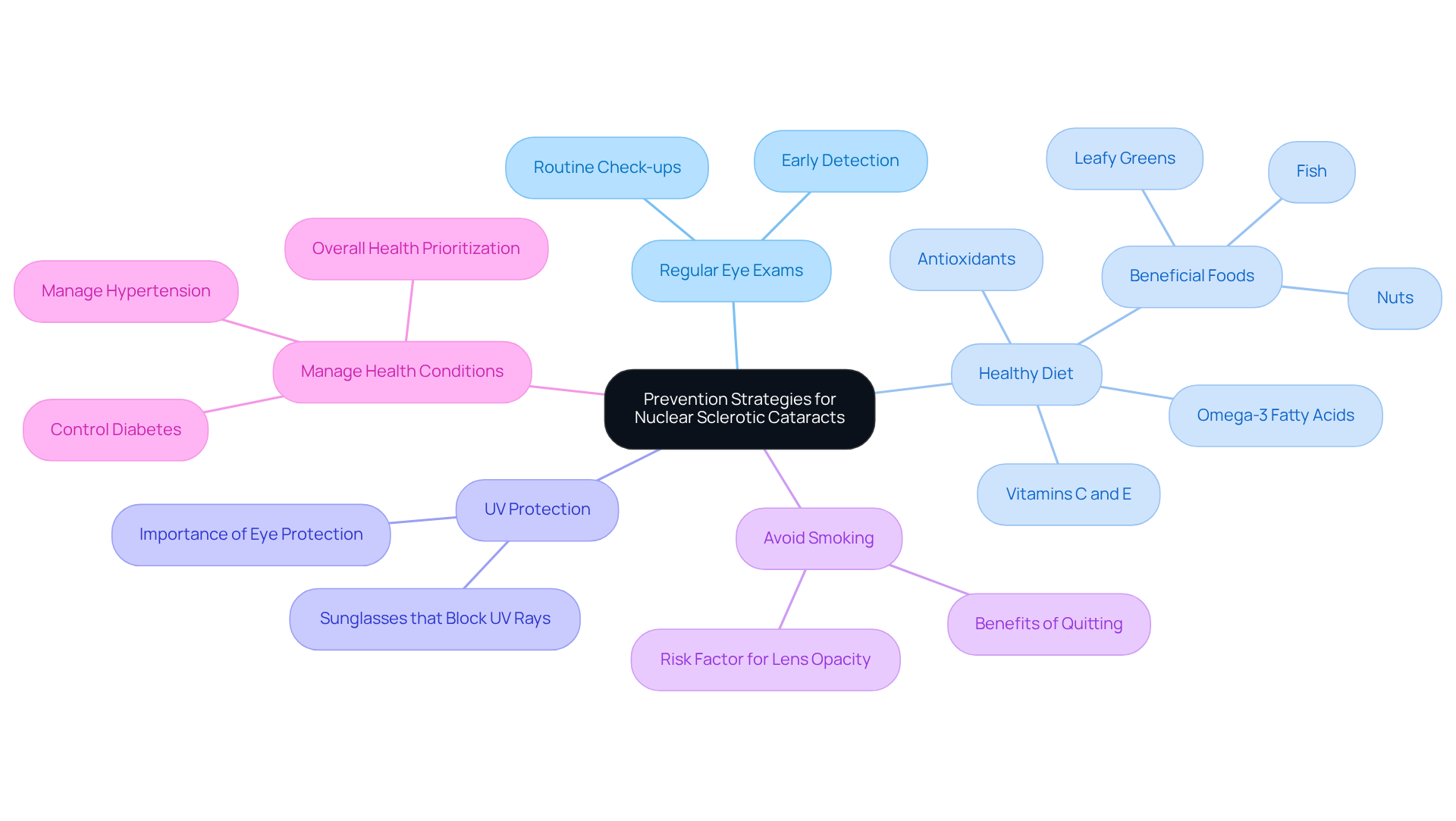Posted by: Northwest Eye in Cataracts, Vision Correction on October 21, 2025
Overview
Nuclear sclerotic cataracts primarily affect the central part of the eye’s lens. This can lead to symptoms such as blurry vision, difficulty with night vision, and changes in color perception. We understand that these changes can significantly impact your daily life.
Recognizing these symptoms early is crucial. Treatment options, like cataract surgery, have a high success rate and can greatly improve your quality of life. Additionally, preventive strategies such as:
- Regular eye exams
- Maintaining a healthy lifestyle
can help manage the condition effectively.
We are here to help you through this process, providing support and guidance every step of the way. Remember, you are not alone in this journey.
Introduction
Nuclear sclerotic cataracts are an important yet often overlooked aspect of eye health. They primarily affect the lens’s central region, which hardens and yellows as we age. We understand that this condition can lead to frustrating visual impairments, such as blurred vision and altered color perception. Recognizing these symptoms early is crucial, as it allows you to seek effective treatment before your daily life is impacted.
It’s common to feel uncertain about what steps to take next. By being aware of the signs and understanding the importance of timely intervention, you can take control of your eye health. Remember, we are here to help you through this process and ensure that your vision remains as clear as possible.
Define Nuclear Sclerotic Cataracts
A common form of cataract, known as nuclear sclerotic cataract, primarily affects the nucleus, or central section, of the eye’s crystalline structure. We understand that nuclear sclerotic cataract can be concerning, as this condition is characterized by the hardening and yellowing of the eye’s transparent structure, typically occurring as part of the natural aging process. As the lens becomes denser and more opaque from nuclear sclerotic cataract, many individuals experience a gradual decline in visual clarity.
It’s common to feel frustrated when faced with blurred sight, difficulty focusing, or changes in color perception, often associated with nuclear sclerotic cataract, which can create a yellowish tint. Recognizing these symptoms is vital, as it allows you to seek appropriate treatment and regain your visual comfort. If you are experiencing unclear sight or any other troubling symptoms, we encourage you to reach out for professional medical help promptly. Remember, you are not alone in this journey, and we are here to help you through this process.

Identify Symptoms of Nuclear Sclerotic Cataracts
We understand that experiencing changes in symptoms of nuclear sclerotic cataracts, which can vary in severity, can be concerning. Here are some common symptoms you may notice:
- Blurry or Filmy Vision: Many patients describe their vision as if they are looking through a foggy or dirty lens. In fact, over 90% report noticeable changes in clarity, which can be quite unsettling.
- Difficulty with Night Vision: Increased glare from lights at night can make driving particularly challenging. It’s common to feel anxious about this, and you’re not alone in your concerns.
- Frequent Adjustments in Eyeglass Prescription: As the condition progresses, you might find that your current prescription no longer provides clear sight, leading to the need for regular revisions. This can be frustrating, but it’s a normal part of the process.
- Color Perception Changes: You may notice that colors appear less vibrant or take on a yellowish hue. This change can impact your daily activities and enjoyment of life, and it’s understandable to feel affected by it.
- Double Vision: Some individuals experience occasional double vision in one eye, which can be disorienting. If this happens, know that you are not alone in this experience.
Recognizing the symptoms of nuclear sclerotic cataract early is crucial. We encourage you to consult with an eye care professional. Together, we can explore appropriate management and treatment options, ensuring you receive the support you need during this time.

Explore Treatment Options for Nuclear Sclerotic Cataracts
Treatment for nuclear sclerotic cataract often requires surgical intervention, especially when symptoms disrupt daily activities. We understand that this can be a challenging time, and we are here to support you. The most common procedure is cataract surgery, which typically involves:
-
Phacoemulsification: This minimally invasive technique uses ultrasound waves to break up the cloudy lens, which is then removed and replaced with an artificial intraocular lens (IOL). This method has a high success rate; studies show that cataract surgery achieves an impressive 98% success rate.
-
Light Adjustable Lens (LAL): This innovative option from Northwest Eye allows for adjustments after surgery, enabling personalized enhancements to your vision based on your specific needs. Many patients, over 90%, report achieving independence from glasses for various distances. To understand how LAL works, we invite you to watch our video featuring insights from our specialists at Northwest Eye.
-
Pre-operative Assessments: Before surgery, comprehensive eye exams are essential to determine the most suitable surgical approach and lens type for you. These assessments play a crucial role in ensuring the best possible surgical outcomes.
After surgery, many patients notice significant improvements in their vision, with most recovering within a few weeks. It’s common to feel anxious about recovery, but vision stabilization generally occurs within 3 to 6 weeks post-surgery. Regular follow-ups are vital to monitor your healing process and address any concerns, reinforcing the importance of proactive care in achieving the best results. Remember, we are here to help you through this process.

Implement Prevention Strategies for Nuclear Sclerotic Cataracts
While not all cases of nuclear sclerotic cataracts can be prevented, it is understood that certain lifestyle changes may help reduce the risk or delay the progression of this condition.
-
Regular Eye Exams: Routine check-ups can help detect early signs of cataracts and other eye conditions. It’s common to feel uncertain about your eye health, but these exams are a proactive step you can take.
-
Healthy Diet: Consuming a diet rich in antioxidants, vitamins C and E, and omega-3 fatty acids may support your eye health. Foods like leafy greens, fish, and nuts are beneficial. We encourage you to explore these options for a healthier lifestyle.
-
UV Protection: Wearing sunglasses that block UV rays can help shield your eyes from potential harm that may lead to lens clouding. Protecting your eyes is an important part of self-care.
-
Avoid Smoking: Smoking is a recognized risk factor for lens opacity; quitting can significantly decrease your risk. We believe in your ability to make this positive change.
-
Manage Health Conditions: Maintaining control over issues such as diabetes and hypertension can assist in reducing the risk of lens opacities. It’s essential to prioritize your overall health.
By adopting these strategies, you can take proactive steps toward maintaining your eye health and potentially reducing the risk of developing a nuclear sclerotic cataract. Remember, we are here to help you through this process.

Conclusion
Nuclear sclerotic cataracts are a common eye condition that can greatly affect vision, especially as we age. Understanding this condition, along with its symptoms and available treatments, is essential for maintaining eye health and enhancing quality of life. With the right awareness and timely intervention, you can navigate the challenges posed by nuclear sclerotic cataracts and work towards restoring your visual clarity.
Throughout this article, we highlighted key symptoms such as:
- Blurry vision
- Difficulty with night vision
- Changes in color perception
Recognizing these signs early is crucial. Treatment options, particularly surgical interventions like phacoemulsification and the innovative use of light adjustable lenses, offer promising solutions for those affected. Additionally, we discussed proactive measures such as:
- Regular eye exams
- Maintaining a healthy diet
- Protecting against UV rays
as strategies to potentially delay the onset of this condition.
In conclusion, taking charge of your eye health is vital. By recognizing the signs of nuclear sclerotic cataracts and seeking prompt medical advice, you can significantly improve your chances of successful treatment. Embracing a proactive lifestyle not only fosters better eye health but also enhances your overall well-being. Awareness and action are key to navigating the complexities of nuclear sclerotic cataracts, ensuring that your vision remains clear and vibrant for years to come.
Frequently Asked Questions
What are nuclear sclerotic cataracts?
Nuclear sclerotic cataracts are a common form of cataract that primarily affects the nucleus, or central section, of the eye’s crystalline structure. They are characterized by the hardening and yellowing of the eye’s lens, typically occurring as part of the natural aging process.
What symptoms are associated with nuclear sclerotic cataracts?
Symptoms of nuclear sclerotic cataracts include blurred sight, difficulty focusing, and changes in color perception, often resulting in a yellowish tint to vision.
Why is it important to recognize the symptoms of nuclear sclerotic cataracts?
Recognizing the symptoms is vital as it allows individuals to seek appropriate treatment and regain visual comfort.
What should I do if I experience symptoms of nuclear sclerotic cataracts?
If you are experiencing unclear sight or any troubling symptoms, it is important to reach out for professional medical help promptly.






